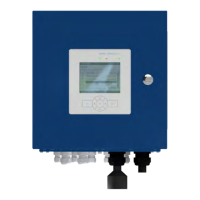6 | Initial commissioning (Quickstart)
D-ISC 100 x xx2
77
6 Initial commissioning (Quickstart)
Prerequisite
● You have selected clear display language:
○
Language setting
(menu 3.2)−
[
System setup > Language]
○
see also Section 9.2 [Language] [}90].
● PIN protection is deactivated (symbol in the status bar) or
enabled:
○
Login
(menu 6) – [
Login / Logout]
○
see 15.4 Example: Clearing the PIN protection (logging in)
[}159].
● You have selected the Expert mode [ Expert mode] for the
display of all menus and menu items:
○
User mode
(menu 1) – [
User mode]
○
see also Section 7.2 [User mode] menu 1 [}81].
6.1 General Start configuration (Quick start)
Before using the D‑ISC100 for the first time, a few settings need
to be stored in the device.
The basic configuration may have already been set at the fact-
ory. In any case, the user will need to check the necessary set-
tings with regard to the local field of application, and make any
adjustments as necessary.
As a general rule, the following must be taken into account for
the start configuration:
Setting See Section
Check the time
(set to local time if necessary)
15.2 Example: Setting/checking the time [}157] ❑
Adding a sensor
15.7 Example: Adding a sensor [}165] ❑
Check the sensor settings
and adjust if necessary
15.8 Examples: Parameterising sensors [}167] ❑
Parameterise the analogue outputs (current outputs)
(as required)
Assigning the source of the measured value 15.10 Examples: Assignment of the analogue output
(current output) [}173]
❑
Set the signal range
(should match the signalrange of the source of the
measured value)
15.10.1 Example: Setting the signal range [}177] ❑
Setting the error information 15.10.2 Example: Setting the error information
[}181]
❑
Setting the overruns / underruns 15.10.3 Example: Setting the overruns / underruns
[}182]
❑
Parametrise the digital outputs
(
as required
)
Assigning the source of the status signal 15.11 Example: Assignment of digital outputs [}184] ❑

